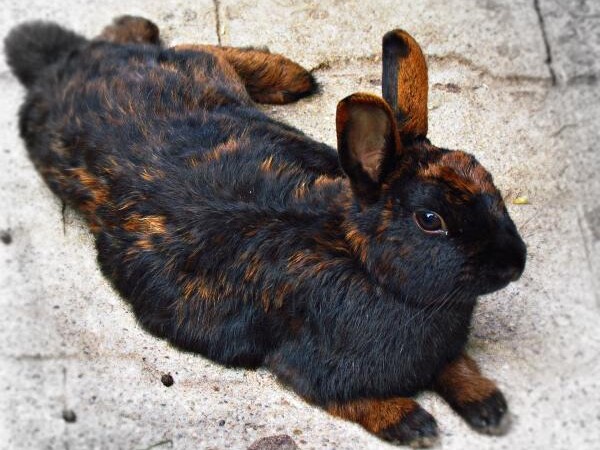

Molting is when a rabbit looses its coat (shedding) and grows a new coat, This is also known as “blowing their coat”. A molt can last from 2 to 6 weeks, or more, it varies from rabbit to rabbit and from breed to breed.
The rabbit molts regularly at different stages in its life. The baby coat is replaced by an intermediate coat when the rabbit is about 4 to 5 months of age. After this molt the adult coat develops, after the adult coat is fully in, The molts are much more noticeable. Molting naturally occurs seasonally but may be brought on by stress and diet, When the adult rabbit molts the rabbits coat may appear very sparse, until it grows in again. This can sometimes leave small bald patches on the rabbit. If the rabbit is healthy the bald spots will begin to become pigmented by new hair growth and then start to grow normally.
The rabbits molt usually begins on the head, moving down the neck and back then towards the stomach, but some rabbits molt in patches all over their bodies. The molt can also get stuck, known as being “Stuck in the molt”. This usually happens on the rabbits flanks, just above the tail, and on the belly. Some rabbits are known to molt almost continuously in these areas. By adding extra protein to their diet, this will help them “blow” their coat faster.
Rabbits shed every three months. Every other time they will have a light molt that may not even be noticed. Then the seasonal molts, which are the heaviest molts are generally at the end of the cold season their winter coat is fully grown and no longer needed for protection. This is the heaviest of the molts. The next heaviest is at the end of summer or in early fall. Their summer coat molts away to bring in the prime thick winter pelt. Rabbits shed in different ways some will take a few weeks others will be ready to get rid of their old coats in a few days and these fast molting rabbits need to be groomed.
Rabbits have the molting process as an aid in controlling their body temperature to the varying temperatures of their environment. Because rabbits are not mouth breathers and can not pant to cool down (A panting rabbit should be viewed as needing attention ). The main way a rabbit can cool themselves is by the blood flowing through the blood vessels in the rabbits ear, these are very close to the surface, and as the blood flows close to the surface it is cooled down. The rabbit needs as many aids as possible to keep cool and molting helps. This allows them to survive seasonal weather changes from very cold weather to relativity hot weather.
So molting helps to control body temperature the rabbits will either add or loose excess hair until the proper body temperature is reached. If rabbits are moved into a heated building what is comfortable for you may not be comfortable to your rabbits, Causing the rabbits molting process to be triggered when normally the rabbit should be growing a prime thick winter coat.
Rabbits should be brushed daily during their heavy molts and at least weekly during the light molts. The more hair you get out of the rabbit by brushing, The less that will get into your rabbits by them ingesting it. You can often remove a large portion of the hair by just pulling it out with your hands. Rabbits are constant groomers so they can get hairballs that can cause bad GI problems. Giving your rabbits lots of hay should help keep their digestive tract moving during this time.
Rabbits cannot vomit so the obstruction of hair needs to pass through the complete digestive system. A small piece of banana will also help keep the gut moving along. During the hot months, a few dandelion leaves will also help add much-needed water to hydrate their digestive track.
Check your rabbits droppings daily during their molts and if you see fecal chains (Poop balls hung together with hair) you need to add more dark greens to their diet, but at least their gut is moving the hair through. If you see no poop then the problems begin. GI stasis can be a real rabbit killer. The digestive system of the rabbit is where you will have most of the health issues with your rabbits.
 Contact Jaguza Support
Contact Jaguza Support